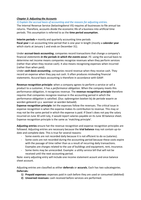Summary
Summary Chapter 3, 4 and 5 Accounting Principles
- Course
- Institution
Comprehensive summary of sections 3,4 and 5 of the book Accounting Principles (12th edition). This material is among other things necessary for the midterm exam and the examination of accounting of study Economics and Business Economics at the Erasmus University. The summary contains pictures from ...
[Show more]



